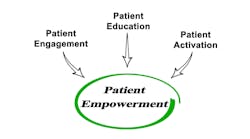Vanderbilt Expands Use of Patient-Reported Outcomes Measurement System
Vanderbilt University Medical Center (VUMC) in Nashville continues to report progress in gathering and doing research on patient-reported outcomes. The Vanderbilt Patient-Reported Outcomes Measurement System (VPROMS) has collected its millionth patient-reported outcome measure (PROM), or pre-appointment survey that patients complete about their health. VUMC says this makes it one of the largest collections of such surveys in the United States.
As the National Quality Forum has noted, elevating the patient voice through patient-reported outcomes (PROs) is critical to achieving equity, strengthening the care experience, and improving health outcomes for all. PROMs represent the tools and instruments that are used to collect the data. PROMs can be used to collect data over time, thereby measuring changes that are occurring for patients and populations. These longitudinal uses of PROMs can form the basis for performance measures (PRO-PMs), where the information is used to hold providers and payers accountable for the outcomes they achieve for their populations, according to NQF.
VPROMS is supported by VUMC's Office of Population Health under David Posch, M.S., executive vice president for population health. “VPROMS is a critical part of the Office of Population Health’s efforts at care delivery transformation,” said Posch, in a statement. “These measures help us improve the quality of life and outcomes of VUMC’s patients.”
The program was launched as a pilot initiative in 2019 by Justin Bachmann, M.D., M.P.H., a cardiologist and medical director of Patient-Reported Outcomes Measurement. The VPROMS team also includes Emily Burnell, Reagan Buie and Emma Barnes.
“We’re out on the forefront with VPROMS,” Bachmann explained in a statement. “Every U.S. medical center likely has some sort of isolated PROM collection effort in one or more clinics, and they may have a depression-screening questionnaire, but very few medical centers have launched institutional initiatives such as ours to collect these data.”
Unlike performance measures, which capture providers’ productivity and adherence to standards of care, or patient experience measures, which focus on care delivery, PROMs attempt to capture whether the services provided positively impact patients’ health and sense of well-being. For example, in a PROM survey, patients might be asked to assess their general health, mood, pain and ability to complete various activities.
Patients receive a patient-reported outcome measure (PROM) survey 72 hours before a clinic visit through the My Health portal at Vanderbilt. They can also complete the survey on a tablet provided at the clinic while they wait for an appointment. VPROMS collaborated closely with the VUMC Paperless Clinic initiative led by Janice Smith, R.N., M.Ed., vice president for adult ambulatory operations.
“At its core, VPROMS is a clinician-patient communications tool,” Bachmann added. “It’s an effort by the Medical Center to listen to patients more effectively. PROMs are really one of the only objective forms of symptomatic data because everything else is interpreted by the clinician and put into the chart. This is a way to cut through that and find out how the patient is actually feeling.”
The data gathered in the questionnaire is added to a patient’s record and is available to patients, clinicians and researchers. When a provider accesses a patient’s PROM data in their EHR, if multiple surveys have been completed, a trend over time can be observed.
“One of the real advantages of collecting PROM data is that it gives you a better sense of symptoms over time,” Bachmann said. “How were they feeling two weeks ago, four weeks ago, eight weeks ago? You can clearly see trends.”
As an illustration of the impact of a clinical practice on patient quality of life in the comparison of the PROMs data collected from patients before and after having bariatric or weight-loss surgery at VUMC. The PROM records a 0-100 score for several patient-reported factors related to their mental, social and physical wellbeing. Before the bariatric procedure, the average score was approximately 40. A year out from surgery, that same measure is over 80, “so the quality of life has essentially doubled for those patients,” Bachmann said.
What began as a pilot project at three clinical sites has expanded to more than 30 clinical sites and can be added to any clinical site that runs eStar, VUMC’s Epic-based EHR, said Bachmann. PROM completion became an Enterprise Pillar Goal for fiscal year 2023. Thus far, 61 percent of patients assigned a PROM survey before a clinical visit completed the survey, exceeding the goal of 60 percent.
The VPROMS data repository, with a million records, is a rich resource for investigations related to patient care, VUMC said. Already, more than $2 million in grant funding has been awarded to support Medical Center research associated with VPROMS data, and that is expected to grow.
For example, Bachmann is the principal investigator for a just-completed multicenter Patient-Centered Outcomes Research Institute (PCORI) study in which a standardized PROM for patients with heart failure was implemented. The PROM data from three medical centers was then uploaded to PCORnet, a secure national database of patient information from multiple healthcare systems, to test ways to use the data to improve patient care.
Bachmann and his team have worked closely with Allison McCoy, Ph.D., director of the Vanderbilt Clinical Informatics Core, to develop ways to efficiently pull out VPROMS data to support investigations.
The VPROMS group has also developed online patient-facing information called MyHealth Snapshot to explain PROMs to patients and patient families and how completing the surveys can improve care.


